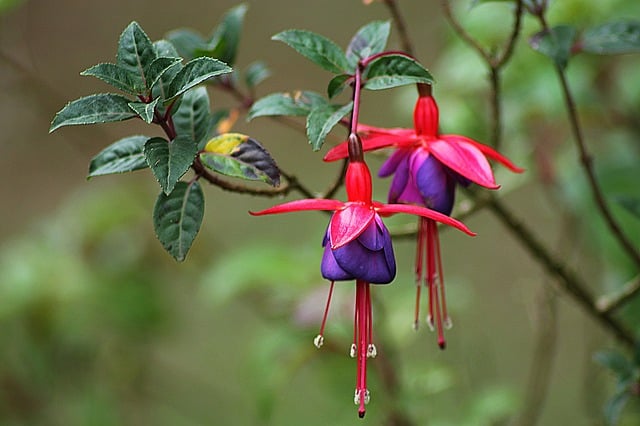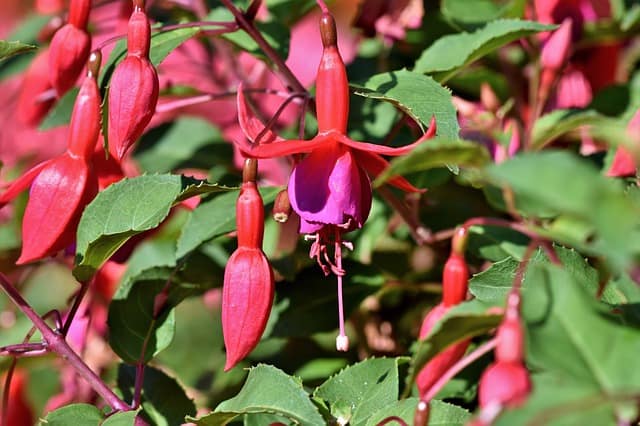Fuchsia plants die mainly due to Fuchsia rust. Magnesium deficiency can kill Fuchsia plants too. They also run into issues when you overwater or underwater them. Fuchsias can be affected by Greenflies(Aphids) and Whiteflies. They are also prone to be attacked by Gall mites.
Fuchsia plants are often kept in pots and hanging baskets. They are kept for their beautiful flowers. There are thousands of Fuchsia plant varieties.
They do not require constant attention, but they need considerable care. Failure to care well may deter the thriving of the plant.
Let’s see what are the signs of each of the above cases and how to fix them.
Why are my Fuchsia leaves turning brown?
Fuchsia plants suffer from browning leaves commonly. This disease is called Fuchsia rust and is caused by a fungus. The leaves look rusted, so the name.
Orange/rusty pustules are seen on the lower side of the leaves. The plant’s growth is deterred as the vigor is lost.
Initially, pale yellow spots/blotches appear on the upper side of the leaves. After a while, the leaves shrivel and fall, reducing vigor greatly.
How do you treat Fuchsia Rust?
Treating Fuchsia rust is crucial as you don’t want the plant’s growth to stall. This can be done in various ways.
- To control the rust naturally, pick off the affected leaves as soon as you see them as the fungus is spread via those rusty pustules.
- Trifloxystrobin is an efficient fungicide against Fuchsia rust.
Why is my Fuchsia plant leaves turning yellow?
Fuchsia leaves turn yellow due to both underwatering and overwatering. Magnesium deficiency can also cause Fuchsia leaves to turn yellow.
Underwatering
As soon as you see yellow leaves, feel the soil with your fingers. Does it feel dry up to an inch or deeper? Then your plant suffers from underwatering.
You should water your Fuchsia plant if the top inch of the soil is dry. Keep checking the soil with your fingers occasionally.
Overwatering
Not only underwatering but overwatering can turn the leaves yellow too. Overwatering causes root rot which in turn hinders the absorption of water and nutrients.
Again, as soon as you see yellow leaves feel the soil. Is it soggy? If yes, then your plant is overwatered.
How do you save an overwatered Fuchsia?
- Fuchsia plants need to be watered early in the morning as the pores close later in the day.
- Try to water only when the soil is dry and try to move the plant into well-draining soil.
- If you grow the plant in a pot feel the weight of the pot. If it feels too heavy, then something’s wrong. Take a look at the actual rootball.
Magnesium Deficiency
Another possible reason for foliage yellowing is the lack of Magnesium in the soil. This happens when the plant has been in the same pot for too long. The plant absorbs all the magnesium in the pot.
Mix Epsom salt in water and add it to the potting mix to fix the Magnesium deficiency in the Fuchsia.
Natural Process
It may just be a natural process. When the Fuchsia grows, the lower leaves turn yellow and fall off. This is to enhance the growth of new foliage.
This is completely normal and you don’t need to panic, just give the plant some time.
Why is my Fuchsia plant not flowering?
Fuchsia plants are kept for their beautiful flowers. What if the plants don’t flower? It’s unbearable and it breaks any honest gardener’s heart.
The main reason why Fuchsia fails to bloom is high temperatures. Fuchsia thrives in lower temperatures with pleasant breezes.
Why is my Fuchsia dropping buds?
I am guessing your Fuchsia buds don’t open at all and they drop down after browning. If this is the case, you probably need to move it to a shady place during the day.
- At night try to move the plant to a place where it gets a cool breeze. Do this for a week or 10 days and see the difference for yourself!
- Transplant shock: Have you moved the plant from the nursery to your indoors? If yes, it might be experiencing a shock. Care well for the plant as usual and it will revive itself!
- Overwatering: Overwatering can hinder blooming. Make sure the soil in the pot drains excess water well. Do not let the soil become soggy, it may lead to root rot.
- Underwatering: Underwatering can hinder flowering too. Try to keep the soil merely moist. Do not let it go dry completely. Check the soil with your fingers prior to watering and water accordingly.
- Air Circulation: Keep the plant on a window sill so that the plant gets the best breeze possible. Ventilation prevents bud drop.
- Remove spent leaves and buds from the pot.
- Cut each branch back as soon as it stops blooming, this increases the chances of a healthy blossom.
Why Fuchsia plant leaves are curling?
The most common reason why Fuchsia leaves curl is pests. Aphids and Whiteflies cause foliage wilting and distortion.
Greenflies and Whiteflies on Fuchsia
Greenflies are green-colored Aphids that are common pests in garden plants. They attack Fuchsia plants with a passion.
Aphids and Whiteflies are easy to control. Look at the curled leaves and see if you can find any pests hanging around.
There may be other possible reasons for leaf curling. Pythium root rot or Verticillium wilt can cause leaf curling too.
Cut off the curled leaves as soon as you see them. If new, healthy foliage appears then the culprits are either Aphids or Whiteflies.
If new foliage is distorted too then it is Verticillium wilt or Root rot.
To fix: Get rid of the plant and the soil. Buy a new plant and plant it in fresh soil. This is the only way if the plant suffers from root rot.

Fuchsia gone woody
Cut your Fuchsia after flowering to promote healthy growth in the next season. You can cut a third off the plant without worries.
You can leave the woody parts as they are to protect the roots from the frost. Cut back any thin or dead branches to promote healthy growth of the plant.
Some people cut the shrub to the ground level to promote new growth in the summer.
Fuchsia Deformed leaves and buds?
If leaves are becoming distorted and discolored then your Fuchsia is probably infected by Gall mites. These are tiny organisms, almost invisible.
To confirm their presence you need to look for specific signs.
- If you see any distorted or swollen areas on flowers, there are gall mites!
- Check the leaves to see if the edges became red or thickened. This is a common symptom of Gall mite damage.
- Look for gray hairs on stems and leaves. If you do see them, then your Fuchsia is infected by Gall mites.
- It’s best to check your plants once in a while and act quickly if you see the above signs.
Fuchsia gall mite treatment
You’d want to treat a Gall mite infection as soon as possible. Flowers will get serious deformations and who’d want so for their Fuchsias?
To treat:
- Once you find an infected leaf, cut it off with pruning shears. Cut the infected leaf 2-inches below just in case.
- If the majority of the plant is distorted and discolored, it’s best to dispose of the entire plant. It helps prevent infection to other, healthy plants.
- Dispose of these leaves carefully. Take all the infected parts and dispose of them in a secluded place. Burn the pile of infected parts.
- If the infection is local and minimal, cut off the infected parts and spray Insecticidal soap.
- Using insecticidal soap just after pruning is an efficient procedure. Spray Insecticidal soap in every corner of the plant, gall mites like to hide in small, inconspicuous places.
- Avoid using pesticides on gall mites as they don’t work at all, I speak from my experience.
How to prevent Gall Mites in Fuchsia
- Sanitize your tools and hands after you work on the infected plants. This helps prevent the spread of the infection.
- Quarantine new Fuchsia plants for 2 weeks before exposing them to the other plants.
- If your Fuchsias are hardy and can tolerate cold, put them out in the cold for a week or two. This helps to get rid of any gall mites.
- Pick a cultivar that’s gall mite resistant.
Frequently Asked Questions
People ask me the same questions over and over again. I decided to answer ’em all here, so everyone could benefit.
How do you make a Fuchsia bushy?
Pinch out the soft growing tips at the right time! Start pinching out soft growing tips in spring and continue till early summer.
Pinching will enhance the growth of bushy side shoots which will be bearing tons of flowers in summer.
Do Fuchsias like Sun or Shade?
They can happily grow in full sun or partial shade. However, do give them shade in the hotter parts of the day.
Do Fuchsias like a lot of water?
Fuchsias if they are in the garden, may need watering once a week. Water when the soil feels dry to touch.
If Fuchsias are grown in pots, you may need to water them frequently. Make sure the soil has good drainage.
Is Epsom Salt good for Fuchsia?
Epsom salt is beneficial to the Fuchsias when the soil runs out of Magnesium. This usually happens in pots. Make a diluted solution out of Magnesium and water. Add it to the soil.
Do Fuchsias die in Winter?
No, Fuchsias won’t die in winter. The plants will stop flowering. They need sunlight. But the best thing to do is let them go dormant. They deserve some rest.
Happy Gardening 🙂

